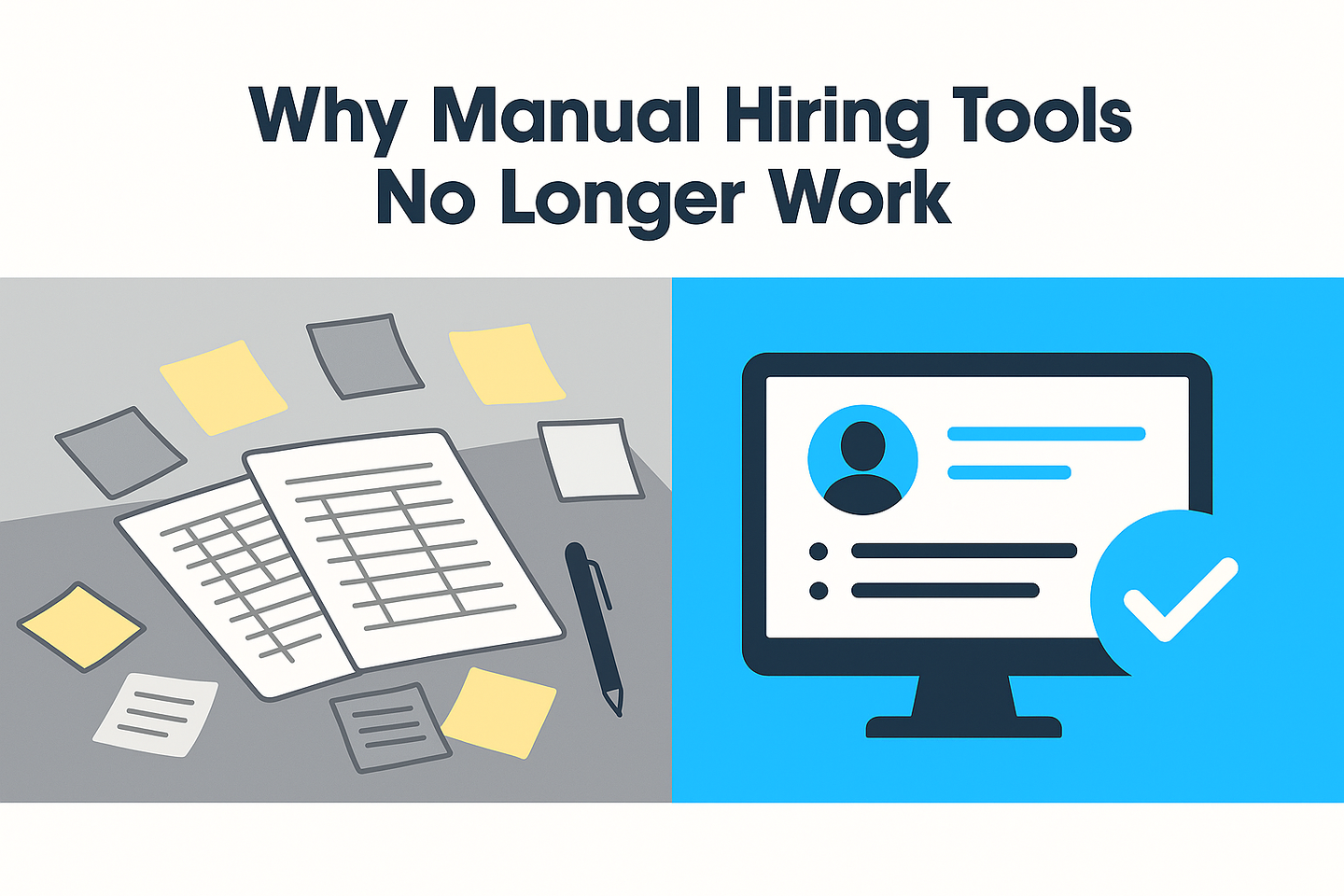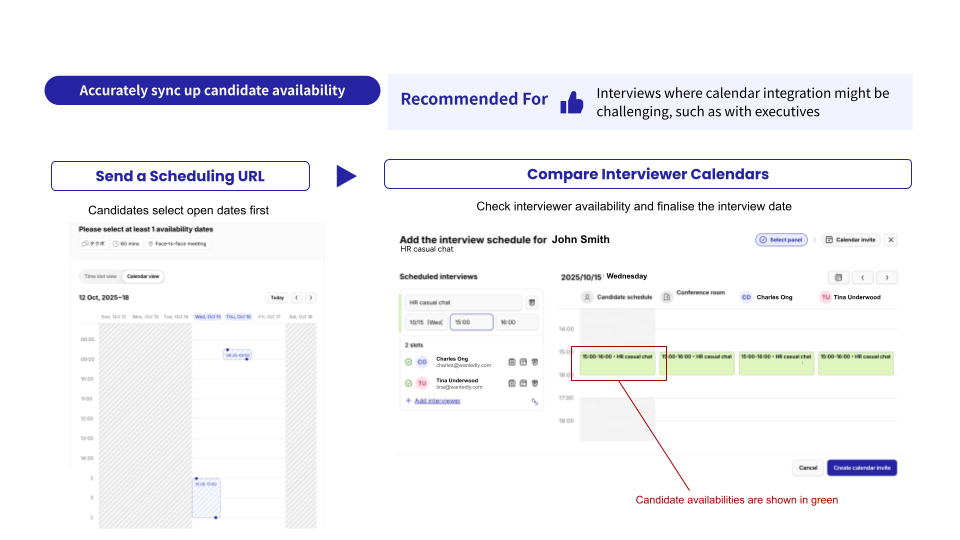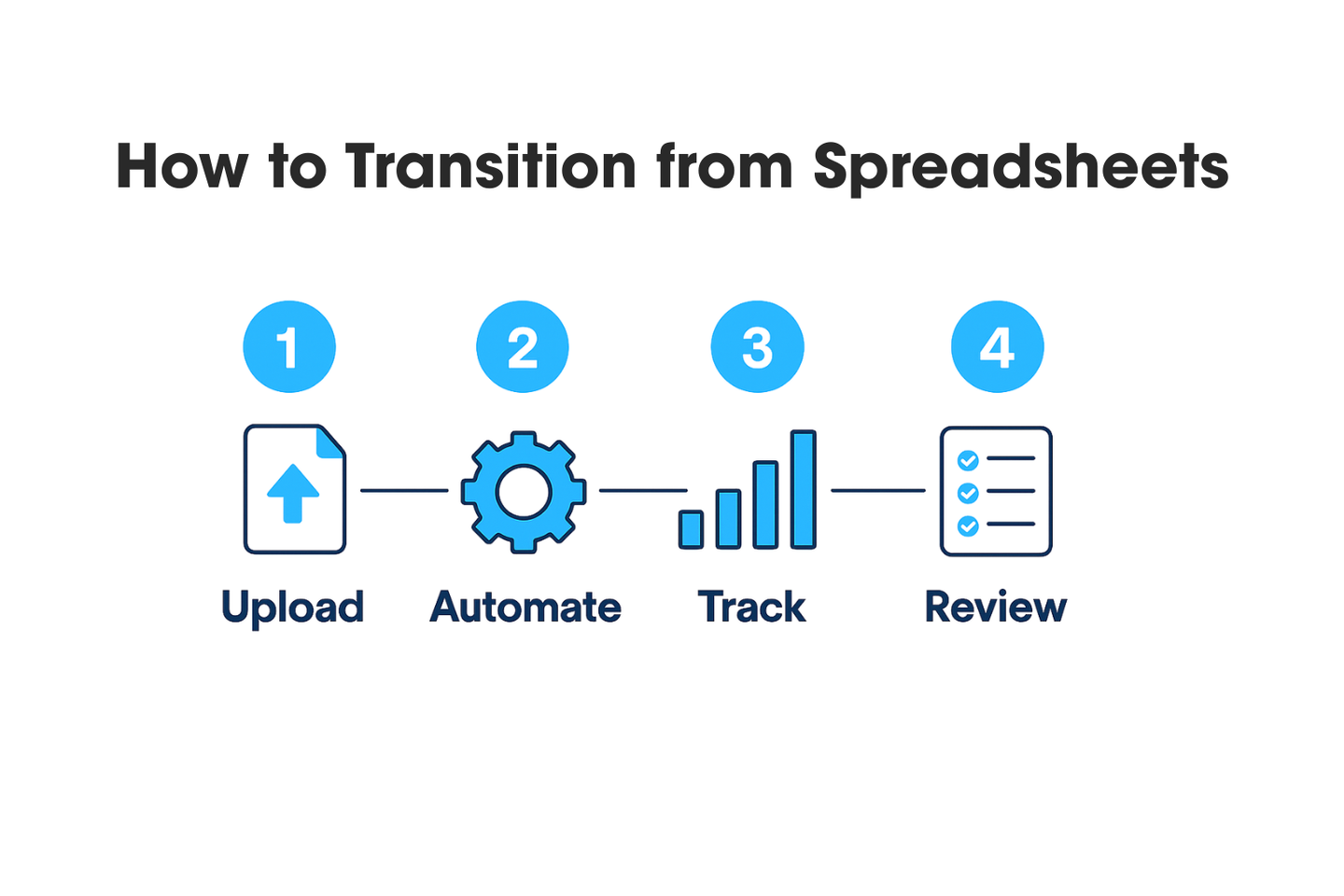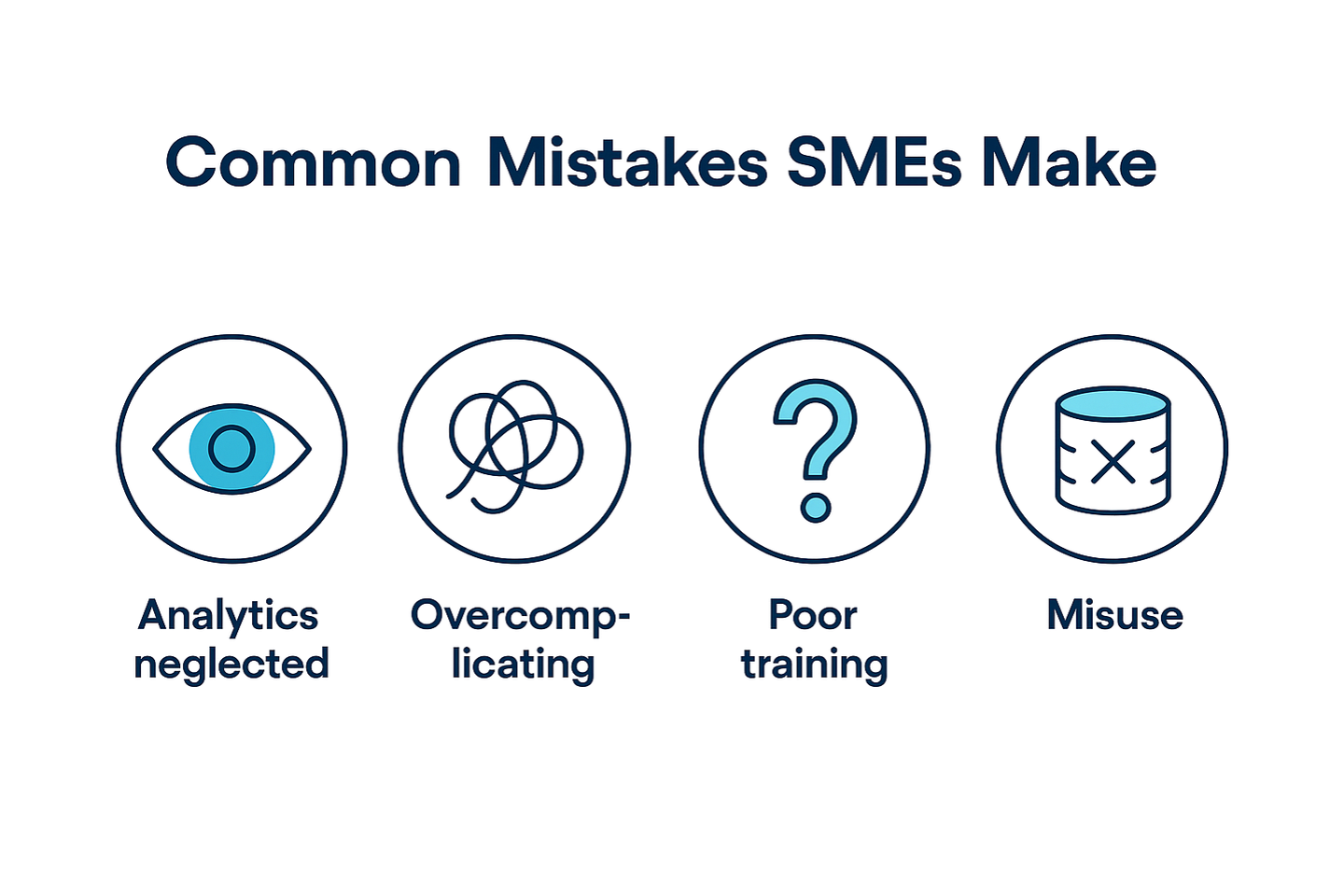#HireSuccess - The Best Applicant Tracking System for SMEs in Singapore
Why Modern Hiring Needs More Than Spreadsheets
Hiring in Singapore is evolving faster than ever. For small and medium enterprises (SMEs), the pressure to find, engage, and retain quality talent has never been higher. Yet, many companies still rely on shared spreadsheets, scattered email threads, and external third-party calendar tools to manage interview scheduling.
This may have worked when your company had fewer than 10 employees. But as hiring scales, these methods quickly collapse under their own weight: missed follow-ups, forgotten candidates, delayed interviews, and unclear accountability. In Singapore’s increasingly competitive talent market, that inefficiency translates into an inconsistent candidate experience.
The reality is that modern hiring now demands more than spreadsheets. SMEs that want to hire talent effectively need an Applicant Tracking System (ATS) that is simple, data-driven, and purpose-built for fast-growing teams. That’s where Wantedly Hire comes in: a platform that transforms traditional recruitment into a streamlined, transparent, and automated process.

Why Manual Hiring Tools No Longer Work for SMEs in 2026
Singapore’s labour market has become more dynamic and demanding. In 2025, business confidence has rebounded sharply, with nearly half of employers planning to expand permanent headcount. However, the same period also shows one of the tightest labour conditions on record, with over three-quarters of companies reporting difficulty filling skilled roles.
For SMEs competing with larger corporations that have entire HR departments and recruitment budgets, manual hiring methods simply cannot keep up.
How spreadsheets slow down hiring and collaboration
Spreadsheets are often the first tool SMEs use, alongside online forms, because they feel simple, flexible, and familiar. But once hiring scales to multiple roles or departments, spreadsheets reveal their weaknesses fast.
Each recruiter or manager tends to maintain their own version of the “master sheet,” leading to version mismatches and inconsistent data. One person might mark a candidate as shortlisted while another unknowingly sends a rejection email. Important notes, like why someone didn’t pass an interview, often get lost in emails or chat logs.
Without a shared system, the hiring process becomes reactive rather than strategic. This disorganisation reflects poorly on your brand too. Candidates left waiting for updates often assume disinterest and move on to other offers.
An ATS like Wantedly Hire eliminates these issues by centralising every interaction and update in one dashboard. Every team member, from recruiter to department head, sees the same information in real time.
How manual tracking increases time-to-hire and costs
Time-to-hire is one of the most crucial metrics for SMEs. Globally, it now takes an average of six weeks from job posting to onboarding, and Singapore’s numbers often run even higher for competitive roles. Those extra weeks are not just administrative lag; they’re costly in real terms.
Every unfilled position means missed revenue, slower project delivery, and stretched teams. The longer a hiring cycle drags on, the greater the risk of losing top candidates who receive competing offers.
Manual tracking is one of the biggest culprits behind long hiring timelines. Without automation, recruiters spend hours on creating new forms, follow-up emails, rescheduling interviews, and updating spreadsheets. This manual effort eats into valuable hours that could be used for candidate sourcing or employee engagement.
Wantedly Hire solves this by automating repetitive actions such as job post templates, interview reminders, scheduling confirmations, and stage transitions. It helps SMEs move from reactive hiring to proactive, data-driven decision-making.
Why collaboration tools inside an ATS make hiring faster
Hiring is rarely a solo activity. It involves coordination between HR, team leads, and senior management. But collaboration often breaks down when communication happens across multiple channels.
Wantedly Hire integrates communication directly into the recruitment process. Just like a CRM, emails are on-platform via our built-in system, so you never have to hunt for an email thread in your Gmail or Outlook inbox again. Comments, feedback, and candidate evaluations are recorded centrally so teams can discuss and make decisions faster. Everyone works from the same version of the truth.
For small HR teams that juggle multiple roles, this level of coordination dramatically improves speed and accuracy. When decisions are logged, follow-ups are consistent and traceable, something spreadsheets simply cannot offer.
What Makes an Applicant Tracking System Ideal for SMEs
Not all ATS platforms are designed equally. Many are built for large enterprises, packed with complex workflows and features SMEs will never use. On the other hand, other cheap ATS solutions are built into general HR software to the point they lose out on critical functions like Slack integration and data analysis.
The best ATS for SMEs should focus on what matters most: ease of use, automation, collaboration, and measurable insights.
How an ATS centralises candidate data for lean HR teams
The challenge for SMEs isn’t a lack of talent; it’s managing data efficiently. Without centralisation, candidate information spreads across job boards, inboxes, and chat apps. Each recruiter spends hours trying to piece together the hiring story.
An ATS consolidates all this into a single interface. With Wantedly Hire, candidate profiles, resumes, notes, and communications are stored in a secure system that can be filtered and tracked by job, status, or source.
This saves time and reduces confusion. For SMEs, where one HR executive might handle everything from recruitment to payroll, having all hiring data accessible in one place is invaluable.
Centralisation also supports compliance. Singapore’s Fair Consideration Framework (FCF) requires employers to document fair hiring processes. Wantedly Hire’s tracking system automatically logs candidate progress and interactions, creating a ready-made audit trail.
How automation helps SMEs save hours every week
Recruiters know that scheduling interviews and sending updates can consume more time than shortlisting itself. Between inviting hiring managers, aligning calendars, confirming availability, and sending reminders, SMEs often spend 30 - 40% of their hiring time on coordination alone.
Wantedly Hire tackles this head-on with automated scheduling and reminders.

Here’s how it simplifies the process:
- Interviewers connect their calendars (Google Workspace, Outlook, or Teams).
- The system automatically detects overlapping time slots.
- Candidates receive a scheduling link and choose their preferred time.
- Confirmation and reminders are sent automatically to both parties.
No more endless email chains or missed time slots. This feature alone saves SMEs hours per week, allowing them to focus on finding quality candidates instead of managing logistics.
How analytics dashboards help SMEs understand what’s working
SMEs often operate on intuition when it comes to recruitment. You might feel certain roles are harder to fill or certain channels perform better, but without data, those insights remain guesswork.
Wantedly Hire’s Analytics Dashboard gives SMEs measurable clarity. You can view:
- Job post performance and page views.
- Applicant numbers for each role.
- Application-to-interview conversion rates.
- Key traffic sources (e.g., job boards, referrals, direct links).
Over time, these analytics reveal clear patterns. You’ll see which roles or departments take longest to fill, which job titles attract engagement, and where most qualified applicants come from. That allows you to refine job descriptions and improve sourcing efficiency.

Why Wantedly Hire Is the Best Applicant Tracking System for SMEs
How analytics make hiring decisions clearer
SMEs typically operate with lean HR teams, sometimes just one or two people. Without visibility into the entire funnel, it’s easy to lose control of hiring priorities.
Wantedly Hire’s analytics consolidate performance data into a clean, visual dashboard. SMEs can track not just who applied, but how they found you and how far they progressed. This makes it easier to pinpoint weak spots, such as a role that receives high traffic but few applications, signalling that the job listing might need refinement.
Having this kind of data-driven clarity empowers SMEs to make confident decisions rather than relying on instinct.
How automated scheduling keeps candidates engaged
In fast-moving job markets, response time defines candidate experience. When interview coordination takes days, candidates lose interest or accept other offers.
Wantedly Hire’s built-in scheduling automation ensures your team responds faster. Once interviewers connect their calendars, candidates can self-book slots that work for them.
This eliminates back-and-forth messages, reduces no-shows, and ensures every interaction feels professional and timely.
Automation also removes the dependence on HR as a bottleneck. Even if your HR representative is out for the day, the system continues to move the process forward automatically.
How a clear recruitment system helps SMEs plan better
Cost predictability matters for small businesses. Many hiring platforms charge in ways that make monthly expenses unpredictable, especially when hiring volumes change.
Wantedly Hire simplifies this by keeping all recruitment activity within one central platform, so SMEs can manage ongoing roles, review performance, and plan upcoming hiring cycles in one place.
This clarity helps business owners and Human Resources teams treat hiring as a structured, measurable process rather than a reactive cost.
How pipeline visibility keeps everyone aligned
Transparency is one of the hardest things to maintain in manual hiring. Team members often ask the same question: “What’s the latest on that candidate?”
Wantedly Hire solves this through pipeline visibility. Each candidate’s status is updated in real time. From the moment the candidate applies, to the screening, interview scheduled, offer extended, or hired.
Recruiters and managers can log notes, record interview outcomes, and categorise rejections or withdrawals. Over time, these data points help identify patterns like frequent dropouts during the offer stage or low conversion from interview to hire.
For SMEs that want control without complexity, this visibility keeps everyone informed and accountable.
See how a structured ATS can transform your SME’s hiring: Explore Wantedly Hire.

How SMEs Can Transition from Spreadsheets to Wantedly Hire
Switching from manual processes to an ATS may seem daunting at first, but it doesn’t have to be disruptive. Here’s how to do it smoothly.
Step 1: Upload and organise your existing data
Export your current spreadsheet and clean it up before migration. Remove duplicates, outdated candidates, and incomplete data.
Wantedly Hire supports CSV uploads so you can move all your active candidates into one system with minimal effort.
Step 2: Automate your scheduling
Once your data is set up, connect calendars and turn on automated scheduling. Candidates can then self-book interviews, and interviewers receive reminders automatically.
This single change immediately eliminates back-and-forth emails and improves candidate engagement.
Step 3: Track analytics from day one
Within a few weeks of using Wantedly Hire, your dashboard begins to show patterns: how many views your job pages get, which sources drive applications, and which roles take longer to fill.
Use these insights to optimise job titles, content, and posting channels.
Step 4: Standardise your monthly reviews
Make data reviews a routine. Every month, compare metrics like page views, applicant conversion rates, and withdrawal reasons.
Tracking these consistently helps your team identify bottlenecks early and take corrective action.
Need guidance setting up your first dashboard? Contact Wantedly Hire’s support team.

Common Mistakes SMEs Make with ATS Tools
1. Not reviewing data regularly
An ATS is only as useful as the insights you draw from it. Neglecting regular data reviews leads to missed improvement opportunities. Make analytics review a monthly routine.
2. Overcomplicating workflows
Many SMEs try to replicate every manual step digitally. Start simple, set up a few essential stages and expand as your team gains confidence.
3. Failing to train team members
Even a user-friendly ATS like Wantedly Hire requires consistent use. Schedule onboarding sessions to ensure every recruiter, manager, and interviewer knows how to navigate the system.
4. Treating the ATS as a database instead of a collaboration tool
Wantedly Hire isn’t just a tracker, it’s a live collaboration hub. Use tagging, notes, and comments to keep feedback visible and actionable.
How to Evaluate and Choose the Right ATS for Your SME
Choosing the right Applicant Tracking System (ATS) begins with knowing what truly matters to your business. For SMEs, priorities often come down to three things: automation, usability, and visibility. The ideal ATS should help you save time, stay organised, and make better hiring decisions without adding complexity.
Features that Matter Most
When evaluating systems, focus on these capabilities:
- Automated interview scheduling and reminders
Helps your team respond faster and keeps candidates engaged without manual coordination.
- Customisable recruitment pipelines
Let's you tailor stages for different roles, from entry-level positions to senior hires, while keeping the process consistent across the team.
- Centralised candidate database
Stores all applicant information, notes, and communications in one secure place, giving your HR team complete visibility
- Analytics dashboards for performance tracking
Provides insights into application volumes, drop-off points, and overall hiring efficiency, so you can refine strategies based on real data.
- Seamless collaboration tools
Allow managers and recruiters to share feedback, track candidate progress, and make decisions together in real time.
These are exactly what Wantedly Hire delivers. We give SMEs a structured yet flexible system to manage recruitment efficiently. It is designed to help small teams scale hiring without unnecessary complexity or hidden costs.
If you are evaluating ATS options for your SME, the simplest way to decide is to book a free demo session with Wantedly Hire. You will see how its automation, collaboration, and analytics features fit your current hiring needs and future growth plans.
Prioritising ease of use
SMEs typically don’t have IT departments to manage implementation. Wantedly Hire’s simple interface is designed for quick adoption. You can start posting jobs and tracking candidates in a matter of days. We also provide onboarding and dedicated account management.
Curious to see how Wantedly Hire fits your SME’s workflow? Visit hire.wantedly.com.
Future Trends in SME Recruitment
These are industry-wide developments that SMEs should keep an eye on, even if they’re not yet part of every ATS platform.
Automation-first hiring
Automation continues to be the biggest driver of efficiency. Wantedly Hire is already part of this movement, simplifying repetitive tasks like scheduling and follow-up.
Tighter integration with communication tools
Recruitment is becoming more collaborative. SMEs will increasingly rely on systems that connect with Slack and Google Workspace for instant updates.
Data-driven decision-making
SMEs are recognising the importance of analytics in improving hiring outcomes. ATS dashboards like those in Wantedly Hire will play an even greater role in future workforce planning.
Frequently Asked Questions (FAQs)
1. How much does an ATS cost for SMEs in Singapore?
Wantedly Hire provides a simple subscription model designed for SMEs. Pricing varies depending on the selected plan and features. To get the most accurate and up-to-date information, visit hire.wantedly.com or contact the team for a free demo session.
2. Can an ATS scale as our company grows?
Yes. Wantedly Hire’s ATS supports multiple pipelines, hiring stages, and team members, making it suitable for SMEs that plan to expand. The system grows with your organisation, so you can manage more roles without adding unnecessary complexity.
3. How long does onboarding take?
Most teams start using Wantedly Hire effectively within one week. The platform’s intuitive design means users can quickly set up their pipelines, automate key tasks, and start tracking applicants without lengthy training.
4. How does Wantedly Hire ensure compliance?
Every candidate action, from application updates to communication logs, is recorded within the system. This provides a transparent audit trail that supports hiring practices aligned with Singapore’s data protection and employment standards.
5. Do we retain ownership of our data?
Yes. Wantedly Hire allows full export of candidate information and hiring analytics. SMEs maintain control and visibility over all stored data.
6. What integrations does Wantedly Hire support?
Wantedly Hire integrates with popular workplace tools such as Google Workspace, Microsoft Outlook, and Slack. For the latest integration options, visit hire.wantedly.com or request a demo to see them in action.
Recap
Singapore’s hiring landscape in 2025 is more competitive, data-driven, and candidate-centric than ever. SMEs that continue using spreadsheets will struggle to keep pace with the speed and precision required to secure top talent.
The best Applicant Tracking System for SMEs in Singapore is one that simplifies operations without compromising insight, and Wantedly Hire achieves exactly that.
With automated scheduling, real-time analytics, transparent pipelines, and a flat-rate model that scales with your business, it turns recruitment from a time-consuming manual task into a predictable, measurable process.
If your SME is ready to modernise hiring, explore how Wantedly Hire’s Applicant Tracking System can help your team hire faster, smarter, and more confidently.
Wantedly Hire is an application tracking system optimised for modern hiring practices. Experience seamless hiring with tailored workflows designed to align with your recruitment structure, automated interview scheduling, and actionable insights to optimise hiring performance!
Sign up for a demo and enjoy a limited-time discount on your subscription.







